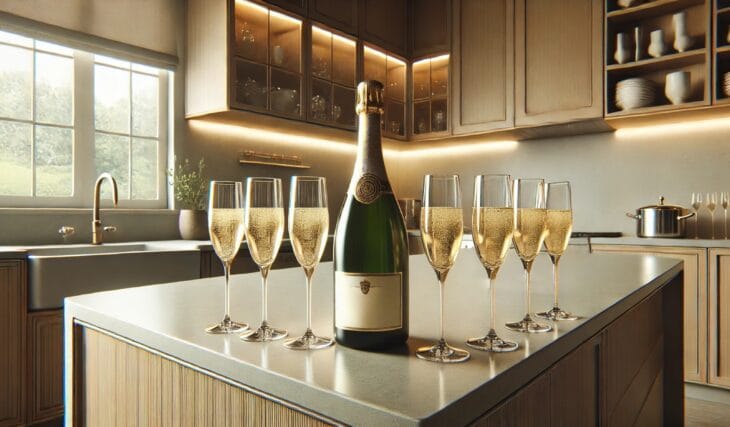How many glasses of champagne in a bottle?
The gentle pop of a champagne cork signals more than just the opening of a bottle. It invites celebration, joy, and unforgettable moments shared with loved ones. Champagne holds a unique place at the heart of special occasions, from intimate gatherings to lavish festivities. It is a drink that elevates the mood and transforms the ordinary into something extraordinary. As you prepare for your event, a common question often arises: How many glasses will one bottle serve?
A standard 750ml champagne bottle typically serves six to eight glasses, assuming a pour size of 125ml per glass. However, this can vary depending on factors such as glass type, the occasion, and how the champagne is served. By understanding these details, you can plan your event with precision and ensure every pour creates moments worth savoring.
Key Takeaways:
- A 750ml champagne bottle serves 6–8 glasses with a standard 125ml pour, or up to 10 with lighter pours for toasts.
- Bottle size matters: Magnums (1.5L) serve 12–16, Jeroboams (3L) 24–32, and Methuselahs (6L) 48–64 glasses.
- Glass shape affects both serving size and experience. Flutes retain bubbles the longest, coupes hold less and lose carbonation quickly, while tulip glasses enhance aroma and maintain a balanced effervescence.
- For large events, plan 1 bottle per 8 guests for toasts or 1 bottle per 2–3 guests for continuous service.
- Serve champagne at 7–10°C and tilt the glass while pouring to maintain fizz and maximize enjoyment.
Understanding Champagne Bottle Sizes and Servings
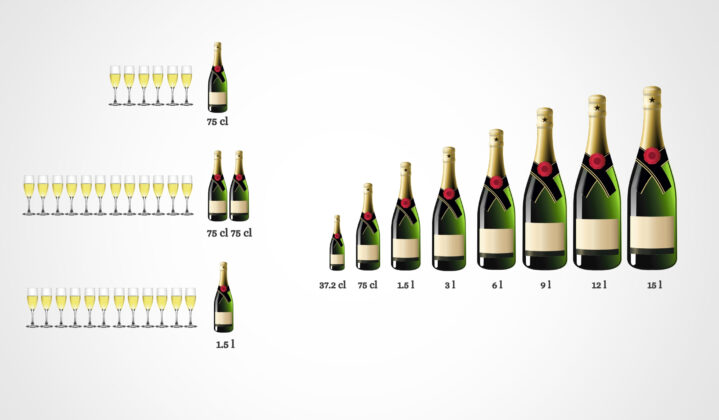
Champagne bottles come in various sizes, and each holds a unique serving capacity. While the standard 750ml bottle is the most common, larger and smaller sizes are worth exploring depending on your event or occasion.
Standard Bottle: 750ml
The classic champagne bottle holds approximately 750ml, which serves about six to eight glasses with a standard pour of 125ml per glass. This is perfect for small gatherings or intimate dinners, ensuring everyone enjoys a glass without running dry too soon.
Beyond the Standard: Larger Bottle Sizes
If you’re hosting a grand celebration, magnums and jeroboams might be your best bet.
Magnum (1.5L): Holds double the volume of a standard bottle, serving 12 to 16 glasses.
Jeroboam (3L): The choice for larger parties, providing 24 to 32 glasses.
Methuselah (6L): A showstopper for extravagant events, pouring 48 to 64 glasses.
Pro Tip: Larger bottles are not only visually impressive but also enhance the champagne’s aging process, resulting in richer flavors.
Half and Mini Bottles
For more personal moments, smaller bottles work beautifully:
Half Bottle (375ml): Perfect for a quiet dinner, serving three to four glasses.
Miniature (187ml): A single serving that’s popular as a party favor or on-the-go indulgence.
The Role of Champagne Bottle Sizes in Creating Memorable Celebrations
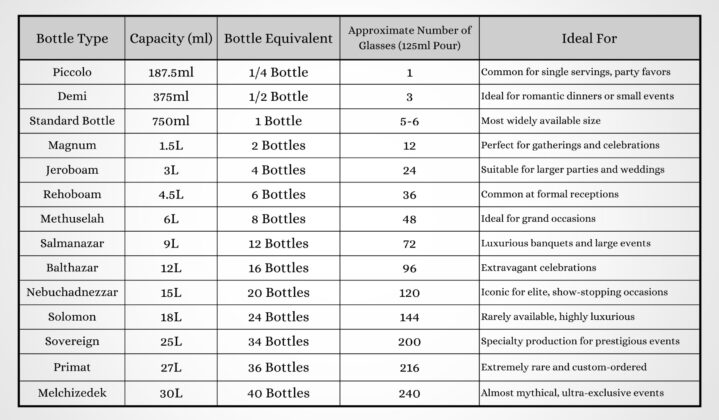 Champagne bottle sizes are more than just a practical consideration—they bring character and versatility to any event. Smaller bottles, like Piccolo and Demi, are perfect for personal moments or intimate gatherings, while larger formats, such as Methuselah and Nebuchadnezzar, make a bold statement at grand occasions. Each size serves a unique purpose, whether it’s to enhance the atmosphere, accommodate guest numbers, or add an element of sophistication.
Champagne bottle sizes are more than just a practical consideration—they bring character and versatility to any event. Smaller bottles, like Piccolo and Demi, are perfect for personal moments or intimate gatherings, while larger formats, such as Methuselah and Nebuchadnezzar, make a bold statement at grand occasions. Each size serves a unique purpose, whether it’s to enhance the atmosphere, accommodate guest numbers, or add an element of sophistication.
Understanding the capacity and serving potential of each bottle allows you to tailor your selection to the event’s needs.
This table provides insight into the various champagne bottle sizes, helping you create an experience that feels seamless and truly special.
What Influences the Number of Glasses Per Bottle?
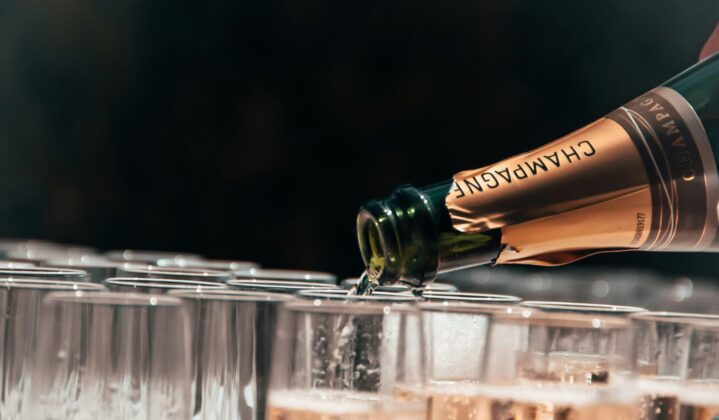 While bottle size is a significant factor, it’s not the only one determining how many glasses you can pour. Let’s dive deeper into the nuances.
While bottle size is a significant factor, it’s not the only one determining how many glasses you can pour. Let’s dive deeper into the nuances.
1. Glass Type Matters
The shape of the glass plays a key role in how much champagne it holds:
Flutes: These long, narrow glasses are designed to retain bubbles and typically hold a standard 125ml pour.
Tulips: Slightly wider at the base, they enhance aromas while holding a similar volume to flutes.
Coupes: Known for their vintage appeal, these shallow glasses hold less liquid, often around 100ml, leading to more servings per bottle.
2. Pour Preferences
How generously you pour affects servings:
Standard Pour: 125ml, balancing bubbles and flavor.
Light Pour: 100ml, ideal for toasts or extending servings.
Full Glass: 150ml, for indulgent occasions but fewer servings.
3. Effervescence Preservation
Ever notice how the first pour seems more bubbly? Champagne’s effervescence can influence serving size, as bubbles often settle in subsequent pours, making it easier to pour more. Smaller, frequent pours not only maintain carbonation but also maximize the number of glasses.
Choosing the Right Glass for Champagne
While the traditional flute remains a favorite, other glass types may elevate the champagne experience:
Flutes: Best for visual appeal and preserving bubbles.
Tulip Glasses: Ideal for appreciating complex aromas and flavors.
Stemless Glasses: Modern and convenient but less effective at retaining carbonation.
Coupes: A classic option, though their wide brim causes bubbles to dissipate quickly.
For a truly elevated experience, choose a glass that complements the occasion and enhances the sensory enjoyment of champagne.
From Bottle to Glass: Champagne Servings Explained
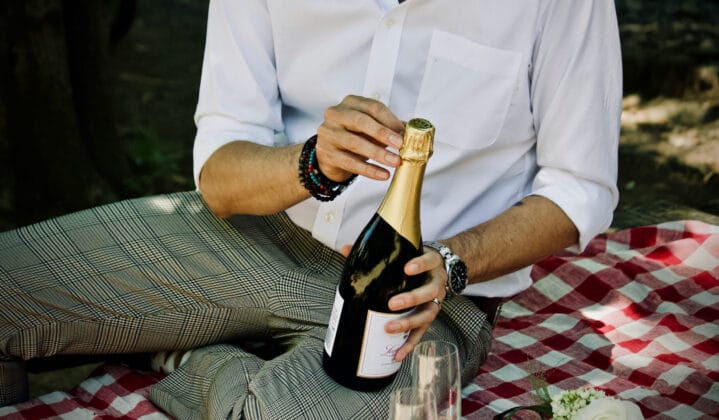
Toasting and Celebrations
Champagne often takes center stage during a toast. For such moments, smaller pours of about 100ml are sufficient, ensuring there’s enough for everyone. This is particularly important at larger events like weddings, where a single bottle can serve eight to ten guests during a toast.
Refills and Continuous Service
At dinner parties or receptions, the frequency of refills becomes key. Servers should aim to keep glasses filled without overpouring, allowing guests to sip at their own pace. A steady, moderate pour keeps the champagne fresh and prevents waste.
Pairing Champagne with Food
Pairing champagne with food can also affect serving sizes. With delicate hors d’oeuvres, a lighter pour works best, while a heartier main course might invite a more generous serving. Champagne’s versatility makes it a perfect companion for everything from oysters to desserts.
How Much Champagne Do You Need for Your Event?
Planning the right amount of champagne depends on the type of gathering:
- Small Dinner Party (4-6 guests): One standard bottle.
- Medium Celebration (20 guests): Five bottles for toasts, 8-10 bottles for continuous service.
- Large Event (100 guests): Around 20 bottles for toasts or 40 bottles for an open bar.
Pro Tip: Always have an extra bottle or two on hand—it’s better to have leftovers than to run out mid-celebration.
Beyond the Numbers: The Art of Champagne Serving
Pouring champagne is more than a functional task; it’s an art form. Serve at the optimal temperature (7-10°C or 45-50°F) to ensure the perfect balance of flavor and fizz. Tilt the glass while pouring to preserve bubbles and prevent overflow. These small touches elevate the entire experience.
A Celebration Staple Worth Understanding
Champagne isn’t just a drink; it’s a tradition, an indulgence, and a symbol of joy. Understanding how many glasses a bottle serves allows you to plan thoughtfully, reduce waste, and enhance every moment of your celebration. Whether it’s selecting the perfect glassware or adding a dramatic flourish with a saber from our collection at California Champagne Sabers, every detail has the power to transform a simple toast into an unforgettable experience. From preserving the bubbles in an opened bottle to creating a moment of spectacle with each pour, it’s all about elevating the occasion.
So, lift your glass, savor the sparkle, and toast to creating memories that last. Cheers!
FAQs:
How many bottles of champagne do I need for 20 people?
For a toast, one bottle of champagne can typically serve 6-8 glasses. For 20 people, you’ll need about 3-4 bottles. If champagne will be served continuously throughout the event, plan for one bottle per 2-3 people, which would require about 7-10 bottles.
How many champagne flutes per 750ml bottle?
A standard 750ml bottle typically fills 6 flutes with a standard 125ml pour. Smaller flutes can yield up to 8 servings.
What is the typical serving size of champagne per glass?
The typical serving size is 125ml per glass, which balances flavor and fizz while preserving bubbles.
What is the recommended amount of champagne for a group toast?
For toasts, a light pour of 100ml per glass is sufficient. A standard 750ml bottle can serve 8-10 people, making it ideal for larger groups.
Can you calculate the number of champagne bottles needed for a large event?
For a toast at a large event, divide the total number of guests by 8 to estimate the number of bottles. For continuous service, plan one bottle for every 2-3 guests for a 2-3 hour event. For example, 100 guests would need about 13 bottles for a toast and 33-50 bottles for continuous service.
How does the size of a champagne flute impact the total number of servings from a bottle?
Smaller flutes can yield more servings per bottle, as they typically require less liquid (100ml). Larger flutes or tulip glasses may reduce the total number of servings to around 6 per bottle.
What is an appropriate quantity of champagne to serve for cocktail events like weddings?
For weddings or cocktail events where champagne is served as a primary drink, plan one bottle per 2-3 guests. For a champagne toast, calculate one bottle for every 8 guests. Adjust quantities based on the event’s duration and other drinks being served. For a wedding with 100 guests, approximately 13 bottles for a toast and 33-50 bottles for full service would suffice.
What is cl and l?
cl and l are metric units of measurement commonly used for liquids, including champagne and other beverages:
- cl (centiliter):
A centiliter is a metric unit of volume equal to 1/100th of a liter or 10 milliliters (ml). It is often used in European countries for measuring small quantities, especially in beverage servings. For example:- 1 cl = 10 ml
- A typical champagne pour might be 12.5 cl (125 ml).
- l (liter):
A liter is a larger metric unit of volume commonly used for measuring larger quantities of liquids. It is equal to 1,000 milliliters (ml) or 100 centiliters (cl). For example:- 1 l = 1,000 ml = 100 cl
- A standard champagne bottle holds 0.75 l (750 ml), which is 75 cl.
These units are interchangeable based on the context, with cl being more common for small servings and l for bottle capacities or larger quantities.
